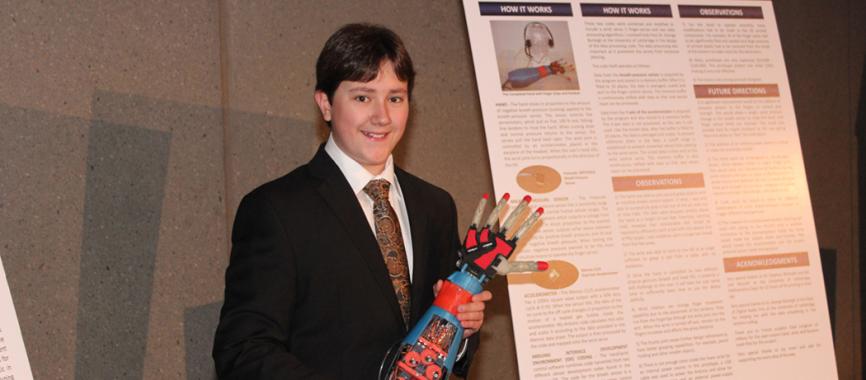2014/2015 Next Gen Innovator
Scientists and inventors are often viewed as people who are working towards the betterment of mankind, and Marin Schultz is a shining example of this caring spirit. Schultz’s work in the development of 3D printed prosthetic arms has opened up a whole world of possibilities for disabled citizens, as these prosthetic arms are being purposed to actively adapt to holding different objects through breath control and head tilt systems. Schultz’s prosthetic arms are on the fast track to being market-ready and he hopes that they will be a new step in the progress of worldwide prosthetic development.
You have been involved in the Next Gen Innovators Showcase since 2014. How has being involved with these events helped your success?
It has given me access to a lot of contacts and connections that I just wouldn’t have been able to find otherwise. It has been really great to be able to meet the top people in STEM from across Alberta, and even make friends with other science fair students!
You were 13 when you had the idea to create a 3D printed prosthetic arm
and invented a breath-pressure control system. What gave you the idea to do this?
I have always been interested in robotics control systems. Several years ago, in 2013, at the Lethbridge Regional Science Fair, my project was an EEG (electroencephalography) controlled robotic hand. The way it worked was, the more the user concentrated, the more the hand would close. That year at the science fair, a one-handed boy came up to my project. I let him try on the headset and he was able to close the hand just by concentrating! He became very excited and said “Dad I can close the hand!” So ever since that moment I have been inspired to build prosthetic arms.
You created something entirely new. Can you describe some of the challenges you faced?
Interestingly enough, almost all of the challenges that I have faced have been not with the breath pressure and head tilt control system itself, but with everything else. For example, it has been very hard to find small motors that are strong enough to open and close the hand for every-day use. One of the other problems is that when the motors are too large, the hand itself loses anthropomorphism (human-like qualities), and the ability to pick up smaller objects as well as more human-like grip patterns. As a result, I have had to experiment with different kinds and sizes of motors to determine which works the best.
You won the Next Einstein Award in 2014. How has this recognition helped your success?
Winning the Next Einstein has been an awesome experience. It opened a lot of doors for me, and the constant support has been amazing. Winning the award has also allowed me to apply for my first patent in the U.S. and Canada for my breath pressure and head tilt robotics control system.
Congratulations on being selected to attend the Canada-Wide Science Fair 2016 in Montreal. What can we expect to see you from you? What are you working on?
Thank you! I am very excited to be going. My most current research and development has been concerned with integrating the prosthetic into its environment using a combination of sensors, and creating fingers that adapt to the objects that they grasp.
Were there any specific people that helped you along the way?
I have had several wonderful mentors along the way who I am very thankful to for helping me learn. My parents have been especially important by always supporting me to do my projects, and always believing in what I am doing.
Do you think that working in Alberta specifically has given you any advantages?
I think the advantage is that it is a small community of highly motivated and high level science and business people who are willing to mentor younger entrepreneurs. Especially, Bill Halley at Alberta Innovates, The Southern Alberta Technology Council, and many of the professors at the University of Lethbridge have been very supportive and helpful.
Where do you go from here?
My prosthetic is always evolving and being developed as I discover new problems, and find ways to solve them. Despite the fact that I will probably always be improving my prosthetic, I am very excited to say that with only a few more years of developing, I will be able to start turning it into a professional product!
I have already been able to get patent pending status in both the U.S. and Canada for my invention which has been an incredible experience learning about the whole patenting process. All of my research so far has been to develop the proof of concept ideas behind my project. So once I finish I will be able to move on to the last stages like miniaturizing all of the electronics, and developing or choosing an arm socket for my prosthetic.

